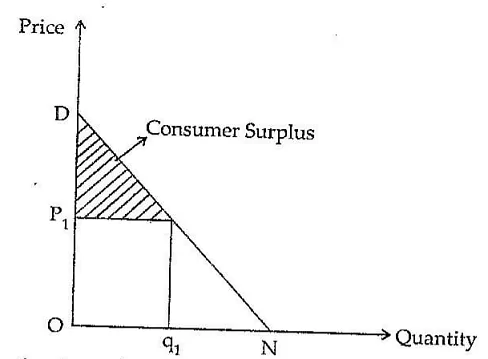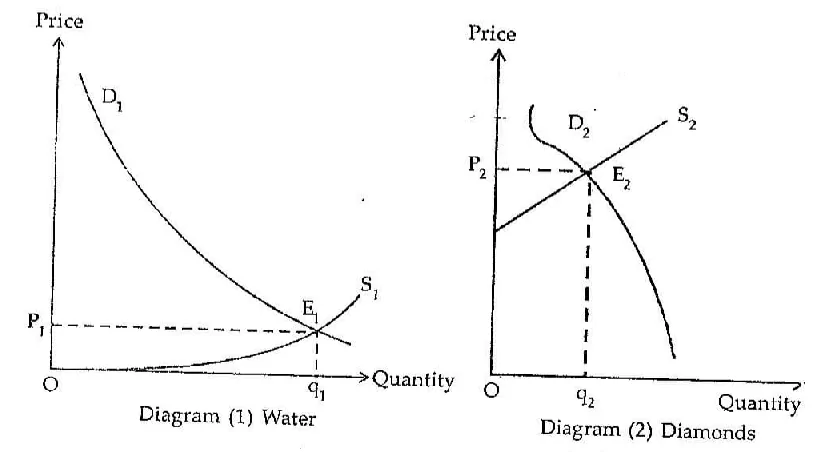Explain the concept of consumer surplus. Using it explain the paradox of value.
The concept of consumer surplus:
Availability of Substitute: More the number of substitutes of a good more convenient it is to shift to one substitute or the other in the event of price change. If a good has no substitutes, the consumer has no option but to stick to the good in the event of price. So, more the number of substitutes of a good more elastic is the demand of that good.
How much necessary is the Good?: The goods necessary for living,for example food items are generally purchased in more or less fixed quantities irrespective of whether they are available at lower or high prices. A change in price of necessary goods may have a small impact on their demand. More necessary a good is the lower likely to be its Ep (elastic price).
How many are the uses of Goods?: The greater the number of uses to which a commodity can be put, the greater its elasticity of demand. Goods that can be put to different uses have elastic demand. For instance, electricity has many uses. It can be used for heating, lighting, cooling etc. When electricity charges are high, it is used for lighting purpose only and so its demand for other less urgent uses will fall considerably.
How much proportion of Income is spent on a Good?: The greater the proportion of the income which is being spent on a product the greater its elasticity of demand will tend to be. Goods on which a consumer spends a very small proportion of his income have inelastic demand, e.g. newspaper, toothpaste, etc. Rise in their prices does not contract their demand. On the other hand, goods on which a consumer spends a considerable part of his income have elastic demand, e.g. clothes, nutritive food, desert cooler etc. Rise in their prices causes contraction of their demand.
Time : Elasticity of demand tends to be more elastic in long period than in short period. The longer the time consumers are given to adjust to a new price, the more elastic will be the demand. If there is very little time for adjustment, demand is likely to be relatively inelastic. Consumer surplus may be defined as the excess of the price which a consumer would be willing to pay rather than go without a thing over that what he actually pays. It is simply a measure of the surplus satisfaction derived by the consumer over and above its price.
Graphically, the consumer surplus may be found by using his demand curve for commodity x and the current market price, which is assumed not to be affected by his purchases of this commodity. Suppose the consumer’s demand curves is given by a downward sloping straight line. DN in following figure and the market price is 131. At this price, the consumer buys q, units for P, price. However, he would be willing’ to pay a higher price for the initial units of x which means that his actual expenditure is less than what he would be willing to spend to acquire q, quantity of good x. This difference is referred to as the consumer surplus.
Thus Consumer Surplus = Total utility derived by the consumer
– Total expenditure made by the consumer
= Area under the demand curve DN
= (Market Price x quantity purchased by the consumer)
= Area (O De q1) – (OP1 xQ1)
= Area (0 De q1) – Area (OP1, eq1)
= Area (P1 De)

The Paradox of value:
The paradox of value relates to the problem of what determines the relative prices of products. Many essential products such as water, without which we can not survive, have relatively low prices. Whereas, some luxury products like diamonds, have relatively high prices, even though they are not vital for our survival. This is generally referred to as the paradox of value.
In order to resolve this paradox we make a distinction between the total and marginal utility. The total utility (Tu) is given by the area under the demand curve. In some cases, that market, value of the commodity has no necessary relation to the total utility that the consumers derive form that amount. Consider the following diagrams.

In diagram (1), the Tu that consumers derive from water is extremely large. It is given by the area under the demand (D1) Indeed we cannot possibly show the curve for very small initial quantities of water because price is going to be very high people would be infact willing to pay all they had rather than be deprived completely of water.
On the other hand, the total utility that consumers derive from diamonds is shown is diagram (2), as area under the Demand curve (D2). The TU is clearly less in case of diamonds as compared to water, The supply curve of diamonds (S2) makes diamonds scarce and keeps their price high. Thus,the equilibrium is at E2. The areas (P2 q2) indicates the total market value of diamonds. While the supply curve of water makes water plentiful and the P1 low.
The equilibrium is at E,. The total market value of water consumed is low and is given by the area (P1 q1). Thus, the market price of a product depends on its demand and supply therefore, no paradox is involved where a product, from which the consumers receive a high total utility sells for a low price and have has only a low total market value (ie. amount is spent on it.)




